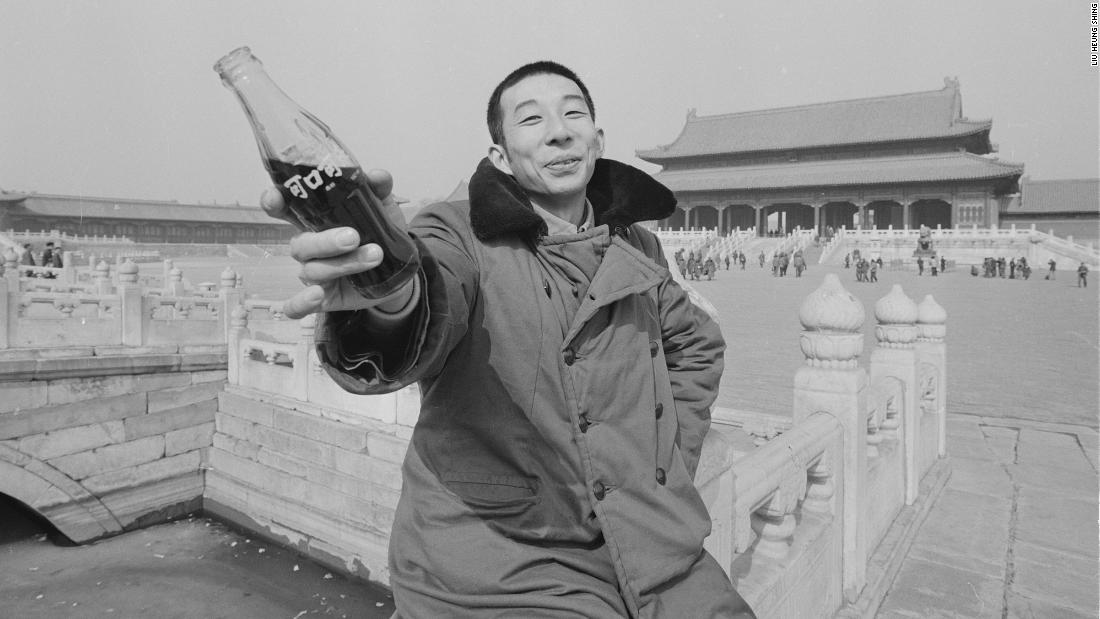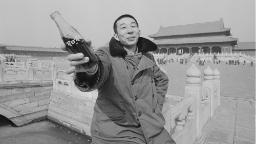

A young man stands grinning in Beijing’s Forbidden City. It’s the dead of winter, and one of his hands is buried deep into the pockets of his long overcoat to protect it from the chill. The other grasps the unmistakable contours of a glass Coca-Cola bottle.
Today, Coke is the world’s most famous soft drink and can be found just about anywhere. But back in 1981, when the image was shot by Pulitzer-Prize winning photographer Liu Heung Shing, it was only just getting into the hands of ordinary Chinese people.
“The changes (at first) were subtle, and unless you lived there, you wouldn’t have noticed,” he recalled during an interview at his home in Hong Kong.
He had earlier photographed people grieving for Mao along the banks of the Pearl River in Guangzhou. It was here that he was struck by how differently people carried themselves compared to what he had seen in late-1950s China, where he grew up during the disastrous Great Leap Forward campaign — a series of failed industrialization policies — before moving back to Hong Kong as a child.
Under Mao, the country went on to suffer from widespread famine and poverty, and the tumultuous years of the Cultural Revolution. But in the aftermath of the Chinese leader’s death, Liu said, “suddenly, people’s steps looked a little bit lighter, they dropped their shoulders and their faces looked more relaxed.”
It would prove to be a relatively liberal period in Chinese history — politically, economically and in terms of everyday life, which Liu captured in candid shots. One photo from the time showed a plastic surgeon and his client after a cosmetic procedure. Another depicted people gathering at a “Democracy Wall” in Beijing, where they wrote now-unthinkable criticisms of the government.
This was China “moving out of the shadow of Mao,” he said.
‘It tastes so-so’
In December 1978, Coca-Cola became the first foreign enterprise permitted to enter the mainland Chinese market since the communist revolution. That same month, Beijing and Washington announced the normalization of Sino-American relations and Deng Xiaoping kick-started China’s transformative economic reforms with his “Open Door” policy. (Coca-Cola was first introduced to China in the 1920s but had been forced to leave in 1949, along with other foreign companies, by a government that regarded it as bourgeois).
Liu had photographed the opening of a joint-venture bottling plant in Beijing, capturing Coke chairman Roberto Goizueta and Chinese trade officials drinking Coca Cola and holding bottles aloft to cries of “ganbei” (cheers). He then thought to himself, “Now where do I find a (regular) Chinese person enjoying this (drink)?”
He headed to the Forbidden City, with its heavy flow of tourists, and soon found a man named Zhang Wei purchasing a Coke from a small stand.
“I remember he made a comment when he drank this syrupy Coke: ‘It tastes so-so'” said Liu, who ended up taking a few shots with one of the imperial palace’s picturesque pavilions in the background.
The response to Coke itself may have been underwhelming, but the snap perfectly captured the curiosity and openness many Chinese people felt at the time.
“As a photographer, I of course realized the significance. That this man, dressed in a ubiquitous PLA (People’s Liberation Army) coat, was one of the very first people to taste it,” he said, adding: “But I didn’t realize it would become part of the Chinese collective memory.”
With its apparent embrace of the new and the foreign — ideas encapsulated in that most American of drinks — the image stands in stark contrast to today’s China, where relations with the US are at an all-time low. Xi Jinping’s nationalist agenda has generated increasingly xenophobic attitudes towards the West.
“I realized that the story I did in the last quarter of the 20th century (would) continue to carry relevance into the 21st century,” Liu said.
“Especially with the story of China, I never doubt that these photographs are in the Chinese people’s collective memory.
“Even though this memory keeps being re-edited… the good thing about a photograph, is you cannot re-edit it. It becomes an image seared in people’s minds.”
Top image: A 1981 photograph of a man with a Coke bottle in Beijing’s Forbidden City, shot by Liu Heung Shing.
